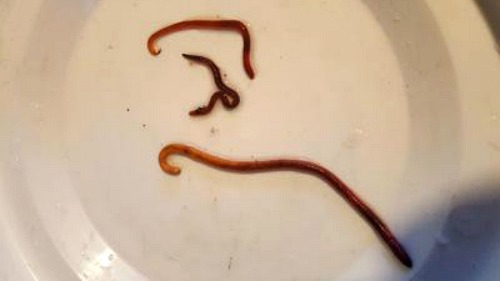Composting Worms for Fishing
by Tony Schollmeier
This is a guide to “composting” worm species, which can be used for bait and readily raised indoors – making them suitable for growing your own. They are also hard to find in bait shops, at least in many locations, so you’ll likely be looking online for them and have to wade through misleading and outright incorrect information regarding them.
Commonly Sold Composting Worms
 From top to bottom: Brandling, Blue, Euro
From top to bottom: Brandling, Blue, EuroEisenia fetida / Eisenia andrei
Commonly called Red Wigglers, Red Worms, Brandlings, Tiger Worms, Leaf Worms, etc. From here on I'll just refer to these as "Brandlings" for clarity. Taxonomy is a little foggy here but they are most commonly accepted as two different but very closely related species. For our purposes these two species are equivalent and the ones I'd most recommend. The clitellum covers segments 25-30. I'll discuss that more when discussing identification of other species. They have noticeable segments and sometimes a striped appearance in their coloration.
Eisenia hortensis
Commonly called Red Worms (sometimes "Big Red Worms" or "Super Reds"), Tiger Worms, Garden Worms, or European Nightcrawlers. If you buy Red Worms from a bait shop there is a good chance you'll get these. For lack of better name, I'm going to call these "Euros" as that is the most commonly used name in the composting world as they are compositing worms as well. The most obvious difference between these and Brandlings is the size, Euros grow much bigger. Euros also have noticeable segments and a striped appearance, their clitellum covers segments 26-34. Meaning this worm has a longer "head," but generally I ID them by the larger size. Juveniles are pretty much interchangeable with Brandlings.
Perionyx excavatus
Most commonly called Blue Worms ("Blues"), so I'll stick with that. They are the Rodney Dangerfield of composting worms, more on that later. But they are commonly sold in "composting worm mixes" and some times turn up in sales of supposedly just Brandlings. The key to identification is that the clitellum covers segments 13-17. This means they have a very short "head," the clitellum is much less pronounced than on the Eisenia species - even in breeding condition. The segments are much less obvious on them as well. They are also much more skinny, have a bluish-purple sheen and move faster and differently than Eisenia species (hard to describe but easy to spot).
Raising Worms Indoors
I'm not going to go into detail here but the Park Ave Worm Ranch is a good primer on an angling centric ranch. I'm using a "Worm Factory" which is much large operation since I'm looking for compost as well. Relevant to this article, Brandlings are the easiest to raise in large numbers in these types of bins. They are tolerant of the widest range in conditions and reproduce quickly. Euros also do well, though they reproduce more slowly and have a narrower range of acceptable conditions. Both are pretty flexible though. Blues have a habit of roaming away from a perfectly good compost bin for no obvious reason. This may be due to a narrower range of preferred conditions, though they well known for this trait so they may just not be "home bodies". If roaming worms are unacceptable in your household I would stick with Brandlings.
Fishing with Composting Worms
The good news is that all these worms catch fish. Brandlings are covered all over this site, they make great bait for Trout, Panfish, Suckers, and just about everything else. Scouring them might even make them better, going off the experiments Les did. I'll be trying it myself at some point. Euros are the ones you are most likely to find in a bait shops, so they definitely catch fish. I won't use them for trout or panfish as they often don't get the whole worm in their mouth. However Euros are valid option for Carp and other large species with large mouths (Catfish, Bass, and many others). Blues lastly do catch fish, in my tests they are comparable to Brandlings. However their skinny body and soft skin means noticeably more lost worms. Perhaps scouring would help.
Bottom Line
Brandlings are great, Euros are an option for larger mouthed fish, Blues work but I'd probably not recommend them to any angler. If you buy composting mix worms, you have no idea what you’ll get but I wager you end up with a fair percentage of Blues in the mix.
TenkaraBum Home > Keiryu Fishing > Composting Worms for Fishing
“The bitterness of poor quality remains long after the sweetness of low price is forgotten” - Benjamin Franklin
"Be sure in casting, that your fly fall first into the water, for if the line fall first, it scares or frightens the fish..." -
Col. Robert Venables 1662
As age slows my pace, I will become more like the heron.
Warning:
The hooks are sharp.
The coffee's hot.
The fish are slippery when wet.
Beware of the Dogma
What's in stock?
Suntech Tenkarakyo 40F Tenkara Rods
Suntech Kurenai II AR39F
Seiryu Rods
Coming Soon
Latest Pages
If you enjoy spin fishing or baitcasting please visit my sister site Finesse-Fishing.com.


